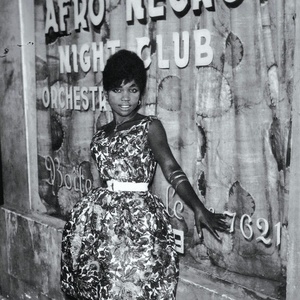
The World Is Shaking - Cubanismo From The Congo, 1954-55
- 流派:Latin 拉丁
- 语种:德语
- 发行时间:2009-06-26
- 类型:录音室专辑
- 歌曲
- 时长
简介
Honest Jons' fifth presentation of vintage recordings from the EMI Archive in Hayes, this album uncovers the dizzy beginnings of the golden age of African music — zinging with the social and political ferment of the independence movement and anti-colonianalism, after the Second World War — and the daredevil origins of Congolese rumba, the entire continent's most popular music in the sixties and seventies. The new music grew in concert with a burgeoning night life — especially in the twin capitals of Leopoldville (today's Kinshasa) on the Belgian side, and Brazzaville on the French, where humming factories lured increasing numbers of rural Congolese with the offer of a steady, relatively well-paying job. Brazzaville had its celebrated nightclub, Chez Faignond, but most of the action took place across the river in much larger Leopoldville. There, Avenue Prince Baudouin, a ribbon of pavement connecting the white ville and black cité sections of the segregated capital, afforded easy access to a giddying number of bars. Labourers and clerks, fresh from work, jostled with thieves and dandies and a few adventuresome whites in the thicket of the Avenue's cross streets. Music wafting from hangouts like the Kongo Bar and Congo-Moderne, the pungent scent of cooking fires, hawkers' cries — Chewing gum! Cigarettes! Roast meat! — bombarded the senses and enfeebled self-control. Inside, beer flowed, and dancers glided in European-style embrace. (Adikwa Depala's song here about the C.C.T., the Congolese Tobacco Company, is encoded with verbal play about cannabis.) The 'coastmen' or popo, West African immigrants who came to Congo for work, headed for the Siluvangi. Henri Bowane's Quist occasionally hosted Brazzaville's Negro Jazz. Nearby, the Air France usually strained to capacity, and beyond it the O.K. Bar would offer its stage and its name to the great band of Franco and Vicky. More numerous open-air bars crowded back yards and side lots, arrayed in lights and fenced to discourage freeloaders. Children hung like bats from neighbouring trees, hoping to glimpse their favourite stars and check out the grownups at play. The astonishing inventions of Europe and America also played an important role in the music's development. Echoes of music exported in the slave trade came home on radios and records. Congolese musicians who strayed from the traditional realm with its plethora of lutes and likembes (thumb pianos) — all the various indigenous instruments — began to master imported guitars and horns by mimicking what they heard. The jazz of Louis Armstrong and the ballads of European torch singers like Tino Rossi captured the imagination of the rapidly expanding working class — and then the familiar-sounding music of Latin America, in the form of the shiny shellac of HMV's GV series of 78s (G for the English Gramophone Company; V for Victor in the US). Local musicians swapped the Spanish of the originals for Congolese languages like Lingala or Kikongo. In his version of Peanut Vendor, included here, on top of his musical changes Depala replaces the seller's cry of 'mani', or peanut, with a lovelorn lament for a woman named Moni — a neat encapsulation of one step in the evolution of Congolese music. The guitarist Depala went on to land a spot in the house-band of the prestigious Loningisa studio. Others failed to gain equivalent recognition, but their music was no less impressive. Listen to likembe player Boniface Koufidilia as he makes the transition from traditional to modern in the first few seconds of BIno, which then hits you with a vamping violin whilst he muses about death (including that of the popular Brazzaville musician Paul Kamba). Andre Denis and Albert Bongu both echo the the sounds of palm-wine brought to the Belgian Congo by the coastmen. The sweet vocal harmonies of Vincent Kuli's track were learned perhaps in a mission church. Rene Mbu's nimble, likembe-like guitar plucking shines on Boma Limbala. Is Laurent Lomande using a banjo as a backdrop to Elisa? Aren't those kazoos, buzzing along on Jean Mpia's Tika? It's as if the musicians, fired up by the times in their zeal for experimental self-expression, tossed into a bottle some new elements and some old, some from near and some far, and then shook it hard, to see what would happen.


![Dreamgirls (Music from the Motion Picture) [Deluxe Edition]](http://y.gtimg.cn/music/photo_new/T002R90x90M000000auXVr4DW8Qf.jpg?max_age=2592000)




